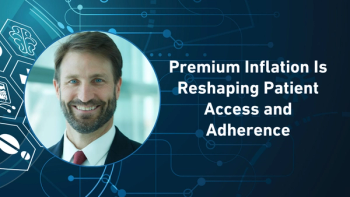
- Pharmaceutical Commerce - July/August 2012
More than just apps: how the cloud helps meet operational goals
Cloud computing can be more than simply accessing databases and computing resources; it can be a pathway to business and research decisions
It is estimated that bringing a new drug to market costs $1.3 billion. In most cases, a pharmaceutical company has only about five years to recoup that cost and turn a profit. Accelerating time to market (TTM), therefore, is vital to extending the sales window and ultimately enhancing a company’s bottom line.
Realizing faster TTM and quicker response to shifting market trends requires a dynamic and responsive relationship with data. Access to both point-of-sale and point-of-service data, for instance, can ease critical business decisions. By understanding patient adherence—which drugs are being prescribed and being used as prescribed—pharmaceutical companies can seek and capitalize on emerging opportunities for rebranding, repositioning, and new product development.
Current clinical trial processes often contribute significantly to the time delays and high price tags associated with bringing drugs to market. Identifying qualifying clinical trial participants, for instance, traditionally is done one partnership at a time, and reconciling vast quantities of clinical trial data from disparate sources also usually relies on labor-intensive processes.
By interacting directly with patient health information, however, pharmaceutical companies can more easily and more efficiently identify possible patients for clinical trials, thereby reducing the time and expense involved in patient recruitment. Similarly, pulling together data from various partners in a clinical trial and harmonizing it faster allows companies to analyze and respond more quickly.
The IT challenge
One obstacle preventing pharmaceutical companies from having a dynamic relationship with data is the diversity of data sources and formats that do not naturally harmonize with one another. The data are out there. The IT challenge is to bring it all together, and then derive from it actionable intelligence that meets business management needs. For example:
- Sales data from around the world are captured in different formats and different contexts, so it needs to be harmonized in order to accurately evaluate global sales. (For instance, a drug in one country may have a slightly different name in another country, or a drug volume in European markets might be expressed in metric terms vs. US standard terms.)
- Clinical trial information is gathered from multiple sources and needs to be assembled for analysis.
- In-house IT departments need to flow data for multiple drug trials to be administered simultaneously.
Companies generally lack the immense infrastructure and expertise necessary to compile diverse data and achieve meaning from it. Yet those that can leverage sales data throughout the global marketplace, as well as patient health and clinical trial information from disparate sources, are better positioned to identify market trends and new operational opportunities.
Cloud solutions: the basics
A cloud-based delivery model is uniquely suited to the challenges facing pharmaceutical companies. In part, this is because cloud-based technology provides leverage, scalability and technology refresh intervals that cannot be matched with traditional software models.
What’s important to understand, however, is that cloud technology can support more than just infrastructure needs; it can also be used to solve business problems. Cloud technology supports three distinct layers of service that build upon each other:
- Infrastructure as a Service (IaaS). This bottom layer is what most people think of when referring to “the cloud.” Companies pay for space and usage—for hardware, Internet Protocol (IP) addresses, CPU space, memory and firewalls, for example—and expand or reduce these as necessary.
- Platform as a Service (PaaS). Although less familiar to most, PaaS is critical to any successful interaction with the cloud. This level provides the tools, capabilities and—more importantly—services that solve problems. PaaS includes things such as integration as a service, data as a service and information as a service. Integration Platform as a Service (iPaaS), for example, is an integration specialty that involves the ability to perform integration in the cloud.
- Software as a Service (SaaS). This level of the cloud hosts the applications—such as dashboards and charting programs—that help visualize the services provided in the cloud. Familiar examples of SaaS applications include human resources packages, sales automation dashboards and stock option apps.
Cloud-based technology operates in the background of a company’s IT systems, allowing the organization to continue using its current systems, while gaining more functionality and scalability. Consequently, cloud-based solutions can be a more cost-effective proposition for data management and optimization.
Ensuring security in the cloud
Data security and privacy are important considerations when using the cloud, especially when health information is involved. Vendors leveraging cloud-based technology are fully capable of ensuring data privacy and security by focusing on access control, security of stored data, and security of data in transit.
Access control involves guaranteeing that only the right users have access to specified data. Features not only confirm the identity of a user, but also control what information each particular user can see and interact with. At the higher PaaS and SaaS levels of cloud use, such controls also can address the cloud-based service provider to ensure it only accesses what it should.
Every level of the cloud, from IaaS through SaaS, requires access control. This activity becomes more complex as the service levels build on each other. To ensure appropriate levels of control, pharmaceutical companies should work with cloud-based providers to develop service level agreements (SLAs) that govern the specific access requirements present in the relationship. These agreements hold the cloud-based vendor accountable and better support effective control.
The details involved with protecting stored data or data in transit should also be covered in SLAs. Protecting data during these intervals can be done in many ways, including through encryption, key management or tokenization. While encryption and key management have been around for awhile, tokenization is an emerging security model used successfully in many industries to reduce the risk of security breaches and protect confidential information.
More specifically, tokenization is the process of replacing sensitive data with surrogates—called tokens—which are words, phrases, symbols or other elements that retain essential information about a piece of data without compromising its security. Out of context, a token is meaningless. And only certain individuals or systems can redeem the token for the original value. Consequently, tokens can be used safely by any cloud-based application or database without risk of exposing sensitive information.
Leveraging cloud services
Although the cloud itself provides a flexible and scalable environment for meeting operational goals, it is the services that take place in the cloud that truly help an organization improve its data management processes. Pharmaceutical companies can obtain useful business intelligence effectively in the cloud through four distinct tasks:
- Connect: As the first step in the series of tasks, “connecting” refers to the ability to join disparate IT technologies to send information back and forth. There are different ways to exchange information (e.g., FTP, HTTP, or Secure SHell [SSH] protocol), but using common protocols can enable connectivity. Achieving such connectivity typically requires large capital expenditures for hardware, software, and other infrastructure—a costly endeavor in terms of money and resources. By contrast, using secure cloud-based technology to connect distant entities or dissimilar systems removes the burden of creating a technology infrastructure, and allows more efficient and inexpensive connectivity.
- Integrate: Integration is tightly interwoven with connectivity. Instead of linking the physical IT “plumbing” or “pipes,” though, integration links the disparate data themselves by making sure they are ready for exchange by mapping and aligning interfaces and data. Data currently exist in a vast number of formats that must be made to flow seamlessly among different “standards” or IT systems. This can be challenging with many data partners and point-to-point connections, but there are different ways to support effective integration. For example, service-oriented architecture (SOA) interfaces might be used to allow multiple components to communicate with one another.
- Aggregate: If more data are being compiled for analysis by pharmaceutical companies, the data need to somehow be aggregated. This involves assembling data from various sources in a method that supports large volumes of information, referred to as “big data,” as well as to enable real-time access. Data aggregation, along with harmonization, provides the ability for analytics to identify operational trends.
- Harmonize: This is the most important step toward true data interoperability. It involves first “transforming” data when necessary into a common, usable format, “normalizing” it to minimize redundancy and dependency, and then “translating” it to equitable semantic definitions. Translation makes it understood, for instance, that “surname” and “last name” used in different fields on different forms mean the same thing. This is the stage at which similarities and differences are reconciled, and actionable information is ready to be obtained.
Case study: Integration Platform as a Service (iPaaS)
The end goal of all these steps to uncover actionable data, of course, is to achieve business results. This is a look at how one large global pharmaceutical company used cloud-based services to realize several distinct objectives:
- Reduce time — the corporation wanted to reduce the number of days required to flow clinical trial data used for analysis
- Achieve scalability — it wanted to address its growing volumes of data and connections as it increased the number of clinical trials performed
- Streamline data mapping — it needed to map key clinical trial data to standard formats
- Reduce costs — it wanted to efficiently use offshore resources to accelerate and streamline processes
- Enhance data quality — it wanted to improve data integrity, reliability and completeness of information in a clinical data repository
Prior to tapping cloud services, this organization was particularly challenged by the harmonization process—readying the different types of clinical data to be analyzed by various systems. (See Figure 1: Clinical Trials Before)
Through the cloud, the company was able to more easily accommodate multiple data standards and formats. It gathered data from multiple types of partners: clinical trial laboratories; the Food and Drug Administration (FDA); clinical research organizations (CROs); joint ventures; and electronic data capture applications (EDC). In the cloud, data were harmonized into a single, usable format that leveraged multiple integration methods and protocols, including APIs, Web Services, SDTM, EDI, and more. (See Figure 2: Clinical Trials After)
As a result of this project, the company was able to accelerate data flow processes, and increase its capacity to handle simultaneous clinical trials with large numbers of participants. This helped the organization reduce costs, while enabling scalability for integration and data transformation. Ultimately, the company was able to speed drugs to market, and position itself to more easily assimilate new business.
Long-term operational utility
Pharmaceutical organizations should not overlook the operational utility of the cloud. The capability exists to perform complex data integration and management functions in the PaaS layer.
Integration and data management performed as a service in the cloud creates several important efficiencies. First, it leverages existing infrastructure and expertise to obtain useful data quickly, which in turn helps speed drugs to market. Second, it allows companies to pay for data management as a service rather than as a technology installation, turning a substantial capital outlay into a more manageable operational expense. Finally, taking advantage of integration and data management as services in the cloud frees existing IT staff to focus on other mission-critical aspects of the data management effort, such as creating applications that further advance operational goals.
Cloud-based services are not just for accessing additional CPU space or extra servers anymore. They can fundamentally change the way an organization approaches and solves complex data optimization problems, leading to greater efficiencies and long-term financial growth.
ABOUT THE AUTHOR
Gary Palgon is the Vice President of Healthcare Solutions for Liaison Technologies, which provides healthcare and pharmaceutical organizations with innovative solutions to complex integration and data management needs. He can be reached at [email protected].
Articles in this issue
over 13 years ago
People on the Move-July/Augustover 13 years ago
Social media sites are stuck on a plateau among physiciansover 13 years ago
2012 PDMA Sharing Conference previewover 13 years ago
The clear and present danger of counterfeit drugsNewsletter
Stay ahead in the life sciences industry with Pharmaceutical Commerce, the latest news, trends, and strategies in drug distribution, commercialization, and market access.




